Year 2 Illustration and Visual Media student at UAL LCC
Don't wanna be here? Send us removal request.
Text
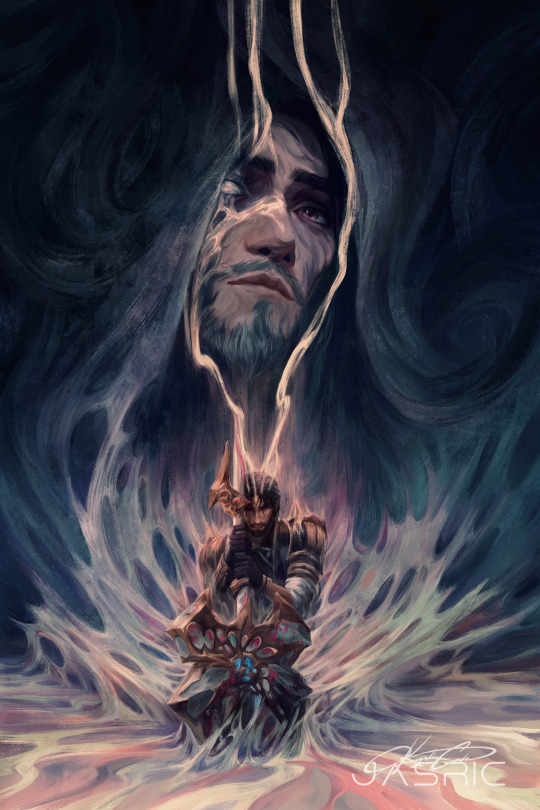


Another one… just endless inspiration It’s so heartbreaking
44K notes
·
View notes
Text

Commander Erwin I’d do anything for the cause (you). 🫶🏻🫶🏻
#erwin smith#illustration#artists on tumblr#attack on titan#commander erwin#digital art#aot#snk#attack on titan fanart#fanart
28 notes
·
View notes
Text
07.10.24 - Research
I have researched these terms and their meaning and uses in context of the creative practices of design, art, animation, film etc. I am considering how they may help me develop or describe my own ideas.
Script:
- Scripts are the narrative to be performed, a predetermined storyline. In coding it is a short set of instructions that automate an otherwise manual process. In all whether it is a computer or actors, a script is instructions to complete an action or dialogue.
- While scripts are predetermined instructions, on a film set actors can take liberty and can add their own creative touch and interpretations into the script.
- “A movie script is a written document that details all of the narrative and visual elements for a feature-length or short movie. This document includes very specific formatting, namely action paragraphs, character dialogue, and in some cases, visual and sound cues.” According to
- In animation scripts go further to direct a a voice actor how to get an animated character to come to life.
- Script fonts appear as if they are handwritten, are highly decorative or look like calligraphy.
Storyboard:
- “A storyboard is a graphic representation of how your video will unfold, shot by shot. It's made up of a number of squares with illustrations or pictures representing each shot, with notes about what's going on in the scene and what's being said in the script during that shot.” According to
- Storyboards can often be the first iteration of an animation except from the concept art, it is the one of the first steps to seeing an animation in its completion.
- Usually, I see storyboard boards used in moving image art pieces like film/music videos and animation, I have also seen it used for comics as a rough draft toward the final piece.
- A script is more of a final iteration of how a narrative will pan out, the storyboard is a draft and the ides so sometimes the final idea may be nothing like the storyboard.
Treatment:
- Having not heard of this term in this context I searched it and “Treatment design is the part of the study design related to what treatments you need to answer your hypothesis/objectives, and how they are related to one another.” According to
- Treatment refers to the way an image is designed or curated to match a look, feel, or brand. (Graphic Design)
- In film the treatment can refer to the document that presents the idea of a film or piece of art before writing the whole script, an earlier stage in the process before script writing and storyboarding.
0 notes
Text
07.10.24 - Tutorial Feedback
I made more concrete plans of how I wanted to direct my retelling of Attack on Titan. The characters in Attack on Titan are so trapped by a pre determined destiny or fate so I am re imagining if they had freedom because a big theme in the show is chasing freedom. The characters are a result of an extreme environment, and I am imagining what would they be like if they had the freedom to grow outside of this universe. Inspired by Kate Bush’s army dreamers.
I will do animate illustrations I draw with small variations to make it visually pleasing but show the characters young, then what they could have been, then the tragic reality that did happen. I made an animatic to simulate what this final piece will look like. And then took the frames to show what I meant further.
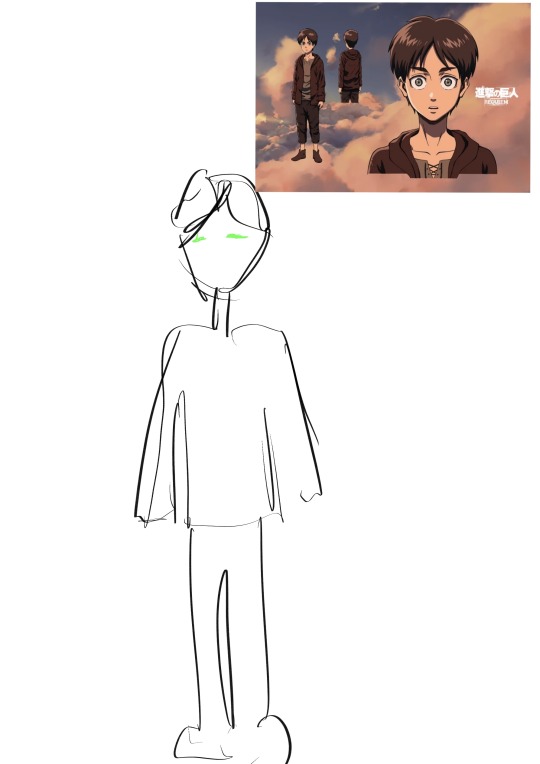
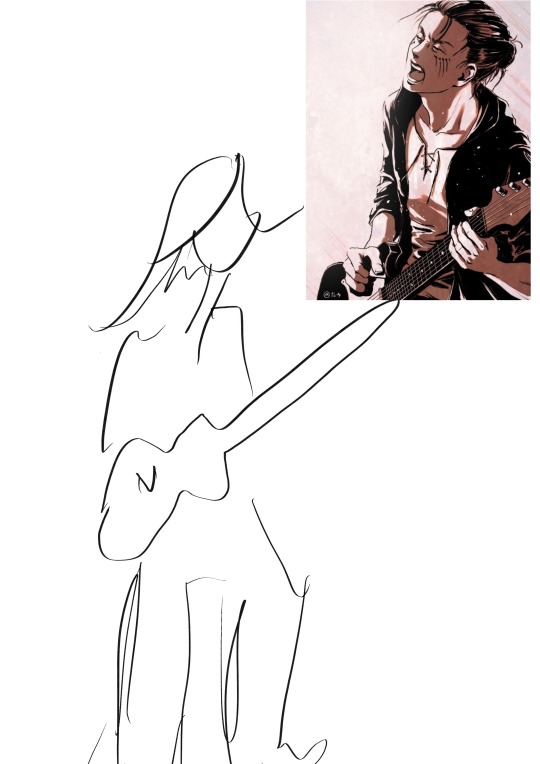
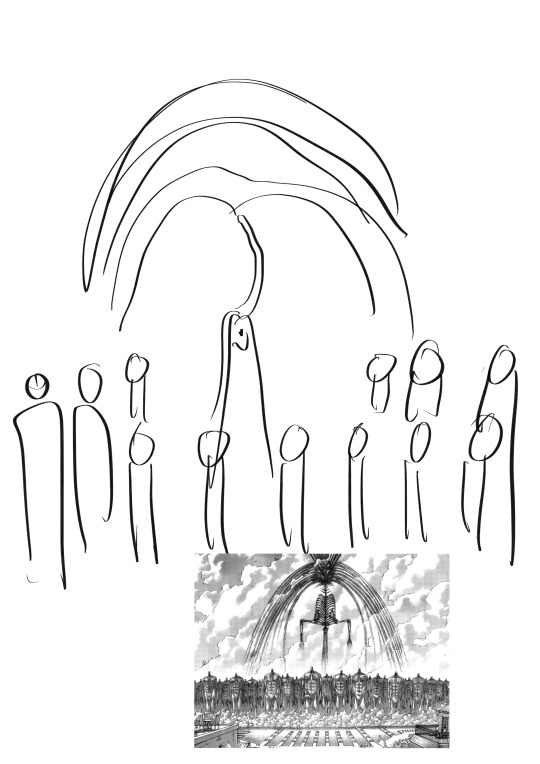
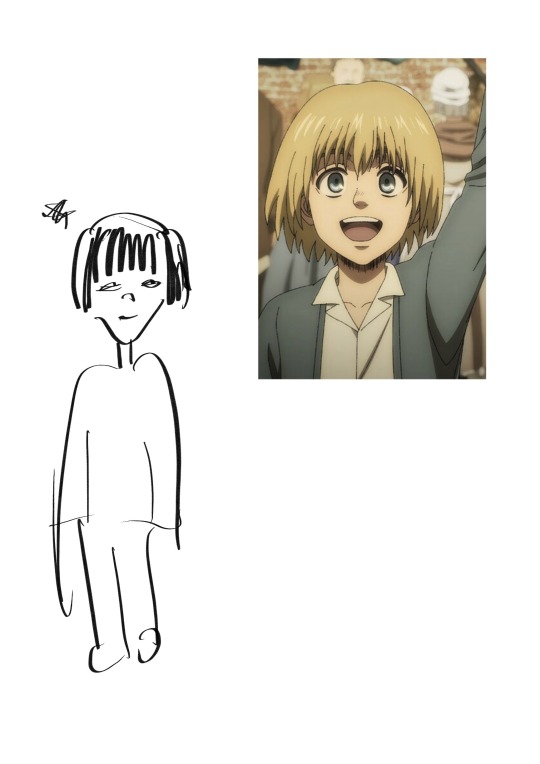
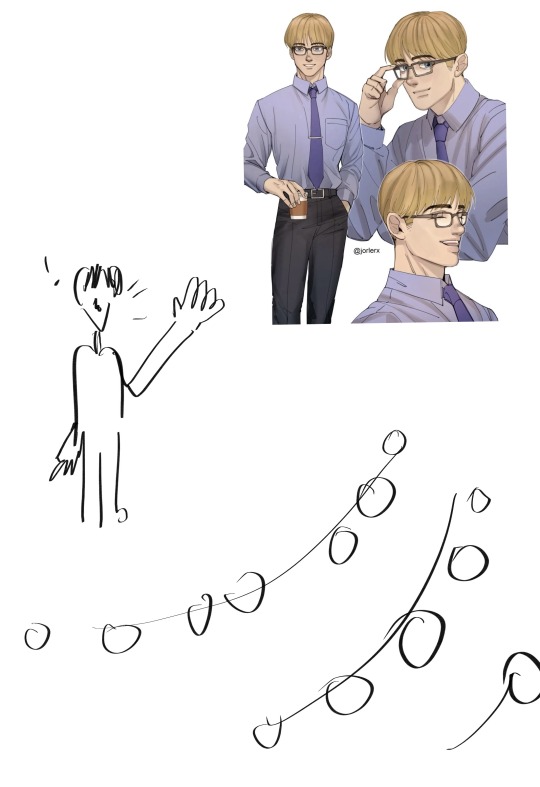



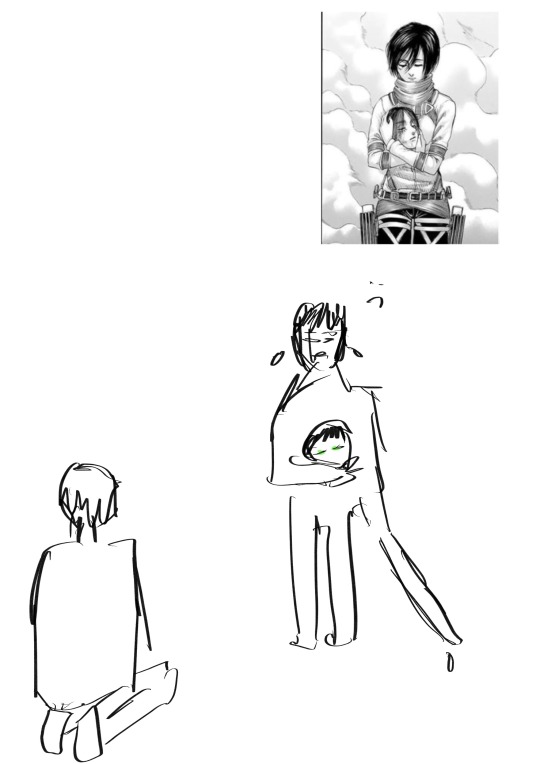

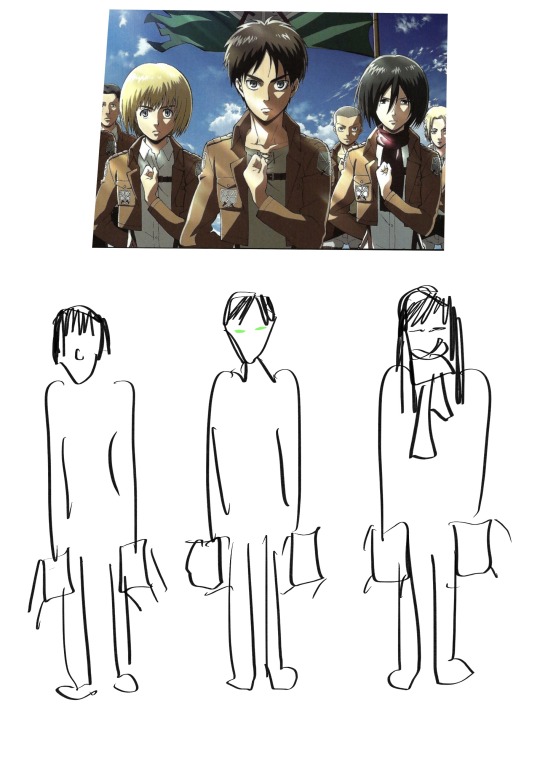
2 notes
·
View notes
Text
Choosing my story to retell
Why I chose Attack on Titan for my Time and Sequence project.
I wanted to choose a piece of media that already had strong time and sequence themes, was something I felt passionately about, and something that had complex ideas and associations. Attack on Titan (Shingeki no Kyojin) is a manga series written by Hajime Isayama that was adapted into an anime series. It of the dark fantasy genre and has strong themes of life, freedom, politics, classism, and cyclical events. Most of these themes are relevant when you look at the first three seasons of the series, but the fourth season introduces a much wider universe.
The series has a complex relationship with time, and it becomes further complicated and distorted as Eren gains more titan powers that allow him to see into the future and past and manipulate events. He was the protagonist of the series and then be damage the antagonist. The plot takes place over 2000 years but is focused on the end 10 years give or take.
Without trying to explain the plot (it is a complicated show) at the end Eren Jaeger (the main character) realises that he could not avoid the path he was on and was a victim to fate, which lead to the annihilation of 80% of the world’s population.
Eren is constantly chasing freedom in the series, from rescuing humanity from the walls that keep humans trapped in but also kept man-eating Titans out, to saving his friends from the wrath of the outside world that wants to kill/oppress the Eldian population. Subtly, this can be represented by the number of chapters in Attack on Titan. In numerology 140 resonates with the personal sense of freedom and 139 symbolises the end (death) of something and the rebirth of another, Attack on Titan has 139 chapters, Eren never achieves freedom.
A character, Ymir, causes the start of these series of events about 2000 years before Eren is even born and when you think everything is over, the epilogue hints at the start of the cycle again, and all Eren suffered was for naught. All that destruction and suffering will happen again. The first chapter is called “To you 2,000 years from now”. I also like that this series so similarly reflects on actual real-life events such as the Holocaust and how humans repeat their mistakes of the past and do not seem to learn.
I want to illustrate something that show Eren cannot escape the movement of time how despite being an all powerful villain with powers akin to a god (he martyred himself to be the villain so that the world would be united to stop him so that they could end the cycle of titans’ curse (he failed because it’s all cyclical and out of his control)). I want this to be the meaning behind my work because to the average viewer Eren is bad because he committed genocide against 80% of the world but as someone who watches the series often, I want to explore the lack of choice Eren had.
Sources:
0 notes
Text
04.10.24 - Briefing
Friday’s Briefing - ESP
Sequences and Time
Key themes: time-based, event-based, sequence.
Re-tell an existing story so that it is present differently. The outcome must convey time and movement. I can choose my own story; could be myth, fable, legend, novel, film etc. could be fictional or non-fictional. It is a ‘story’ news, article, a monument, music, a poem, archival footage, artwork.
I must re-tell the story according to my own interests and intentions. Could include a different perspective, an adaptation, a reimagining in a different context. I must consider what are the new and different meanings and messages associated with my story, what elements am I focusing on, how else could the info be presented?
My realised outcomes must show a consideration of time and movement. This could be presented as movement through time in a static sequence, a moving image, animation, or film. Think how time and movement can be conveyed with different media forms, imagery, and sequence, and how does time and movement relate to my story.
To me this brief seems like a fan fiction task. I already create fan art for various pieces of media. With the title being time and sequence, it makes me think of Attack on Titan, the first and last episodes are related in terms of time.
Tasks and ideas:
- Watch a piece of media and sketch key points.
- Time could be shown in seasons.
- Eren (Attack on Titan) could be running from time/ his past and future self.
- Zine or book showing sequence.
- Consider, do I need to cast characters
Examples:
- Charlotte Mei and Chris Harnan Lord of the Rings magazine.
- Daniel Savage (animation relating music and a machine that draws).
- Michael Lin for Hermés.
- Wendy Red Star, Four Seasons photographs.
- Carole Maillard, From Film Notes series of Sketchbooks - Little Forest by Im Soon Rye.
Discuss: Remakes and Adaptations
Harry Potter Series - successful but due to the limitations of film being 2-3 hours long it missed a lot of book scenes, they also changed the characters to be more to the standard of Hollywood romance. For instance, they took away Ron’s intelligent moments and gave them to Hermione so that they could exaggerate the stereotype of the dumb sidekick and intelligent girl who does everything for the main character (Harry).
Little Women - the most recent film adaptation is formatted into the past and present, it flashes forward and back and there is the stark contrast of the two tones of each time. But older adaptations of Little Women do not do this. Neither do the books.
Other examples; Disneyland, 80s horror films, Arcane (League of Legends), Shakespeare, Graffiti, Five Nights at Freddy’s.
Adaptations
We had to adapt a short clip and I chose 2001: A Space Odyssey, 1968. I decided to reverse the role of the skeleton and monkey/chimp.
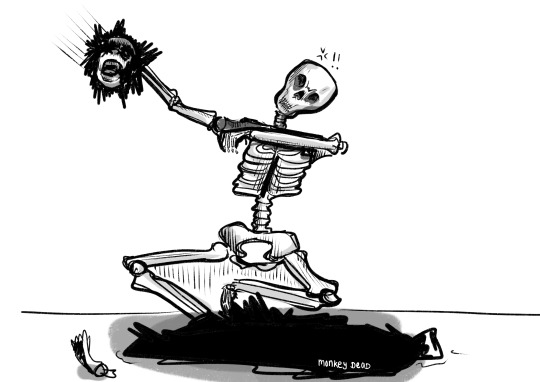
0 notes
Text
Artist Research - Robert Sae-Heng
Graduated from the University for then Creative Arts with a BA in Illustration and now lectures on an illustration programme. He documents his travels and explorations with pencil and paper, he illustrates cultures that aren’t his own to ‘better understand his place in the world’.his work is used in advertising, magazines, and restaurant branding, he has also illustrated a book.
Sae-Heng was born deaf and used art to communicate and it also helped him to process the challenges Sae-Hung faced as a working-class child in rural Mexico. His artwork was being used to communicate before Sae-Heng could read, write, or speak, so it became a form of escapism.
Robert Sae-Heng uses colour, texture in the form of mixed-media. He uses hand drawn images and then finishes digitally. Some of his works have also been animated, like on his website.
Running helps Sae-Heng overcome a creative block because it is how he subconsciously processes his ideas and finds clarity; it also has benefits to his mental and physical health. Sae-Heng often questions wether his work will be able to sustain him 10 years into the future, but his solution is to have faith in his own abilities, he knows he has the skills and experience to continue his career.
If I were doing Robert Sae-Heng’s work I would enjoy it because I like the mix of traditional and digital work. I’d struggle holding workshops for others because I do not have that edge on others to be able to teach them skills I have not perfected myself. I think that I would incorporate different types of traditional media like print and not just pen and paper then finish on a digital platform.
In the scale of the world Sae-Heng is successful and I can see myself being a similar sort of position because creating art for magazines with a brief makes more sense to me, I sometimes struggle to create art for the sake of art and have to do something guided so I think it would be beneficial for me. Again, compared to Sae-heng I am an illustration baby but seeing his journey being similar to mine in terms of communication, makes my future more clear.

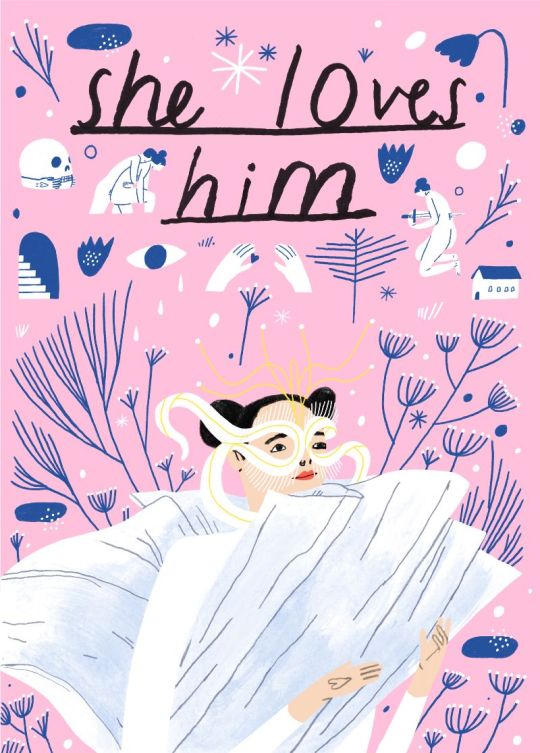
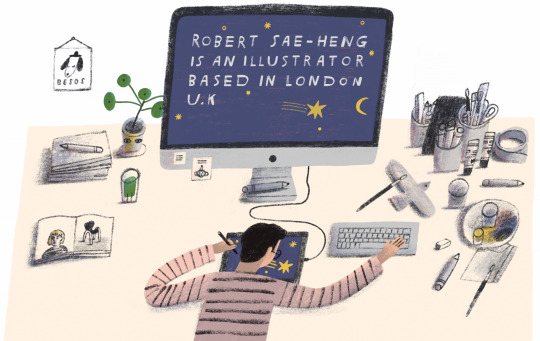
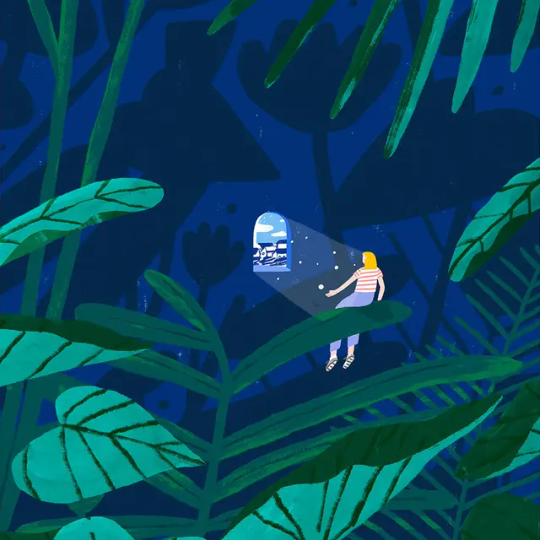
Sources:
0 notes
Text
My Creative Process and Motivations
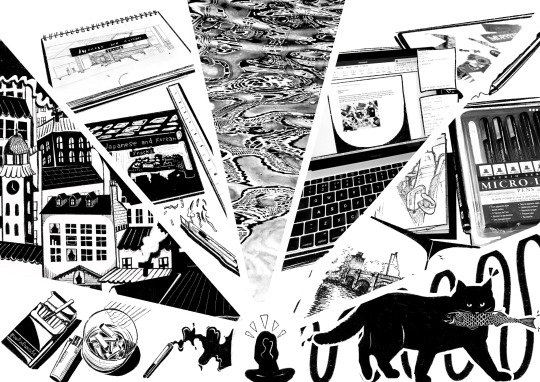
My creative processes and motivations are illustrated in this image represented as rays of light stemming from me. These are aspects of my life which are reflected in my works, my need to smoke, living in a busy city, siting in a print studio, the textures of the world that stimulate me (sometime over stimulates), the research I do, observational sketching and cats! I made myself small because my work is a reflections of my surroundings not how I look.
2 notes
·
View notes
Text
Artist research - Wuon-Gean Ho
I chose to research Wuon-Gean Ho as my practitioner whose work I am interested in because I’ve been following them for a while on instagram and I am always inspired by their work. I love the sheer volume of work produced and the freedom of narratives and perspectives.
Ho makes prints, books, and animations and has ben printing for 35 years. Initially, she did a degree in veterinary medicine and then studied Japanese woodblock print making in Kyoto on a Japanese government scholarship. She also has a BA in history of art from Cambridge university and did a MA printmaking at the Royal College of Arts. Ho learnt to print as a child then did it in her spare time for 14 years before learning it formally. Currently works in East London Printmakers, a collaborative studio.
For her materials Ho uses Japanese vinyl which is similar to Lino cuts. She uses separate blocks for each layer of colour. She prints the first colour onto another block then carves out for the next colour onto the block using chalk to set the ink. Then uses an Albion press (cast iron press to push ink onto the paper. Ho uses sakura oil-based relief inks because of their intense colour and make vibrant blends and are easy to wipe.
Wuon-Gean Ho draws directly onto the printing block from her memory and imagination. She finds drawing from life ‘favours a photographic view of the space’ so she uses her imagination to draw wide angled perspectives to produce works with ‘dream-like’ logic. Ho hides stories, clues and times and images into her works to create a richer narrative. Her narrative is ‘a little satirical, a bit tragic, sometimes absurd’. Ho is inspired by situations, the way people move, funny things she overhears, many of her works include snapshots of life which is what I lover about her work.
If I was doing the work Wuon-Gean Ho is doing I think I would be really happy as I could produce lots of work with a large amount of freedom. I am always happy in a print studio so to have access to the East London Printmakers would be a huge privilege. Although, if I were doing only what Ho is doing, I would miss doing my digital illustrations because her work is mostly physical. But I like her sketches also.
I think Ho’s position in the illustration world is highly successful and and compared to me she is very high up however I am in the process of getting my own degree and she has several. She has been doing this for many years and I am still young so I don’t feel disheartened but I feel inspired because Ho could be a reflection of my future as a printmaker. I aspire to be like Wuon-Gean Ho but with a more digital side. I feel lots of her work is similar to what I do and would like to continue doing, for example the narratives and situations illustrated in her prints.
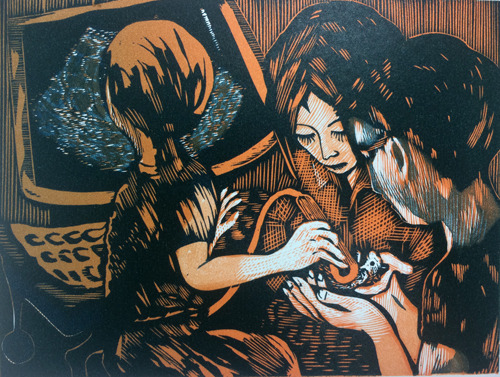

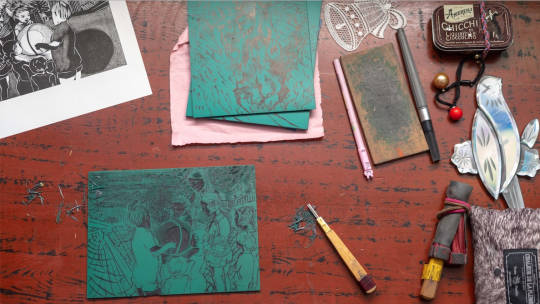
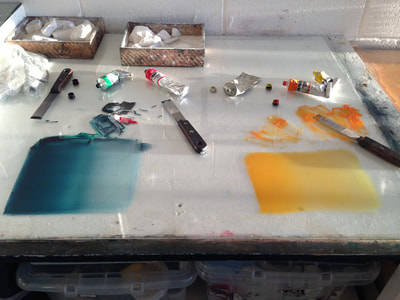
Sources:
0 notes
Text
30.09.2024 - Manifesto
In our first class back from the summer holidays we wrote manifestos to help motivate ourselves through the year. I am thankful for the fact we are being eased back into lessons. We have to be upfront with our values and beliefs and in the end I made something is half affirmations and a guidance for when I feel down.
We answered some questions:
What am I good at?
Cooking, prints, illustration, organisation, empathy, observing, documenting memories, logic and maths.
What am I challenged by?
Group work, confidence, perfectionism, mental and physical health, unfamiliarity, spiders nad bugs, unemployment, societal expectations.
What do I care about?
Family and friends, cats, personal time and space, aesthetics, culture (Thai and Judaism), respect, tattoos, piercings, hygiene and order.
What inspires me?
Cats, Pinterest, nature, literature, weather, media (film and tv) decor, strangers (people observing), when my friends succeed, music.
I transformed these questions into my manifesto.

We then put up our manifestos up on the wall and I enjoyed seeing others thoughts and inspirations but it was hard for me to share as it felt quite vulnerable. But overall I enjoyed the collaborative aspect because it helps put into perspective that we are all on the same page, we are all starting a new year.
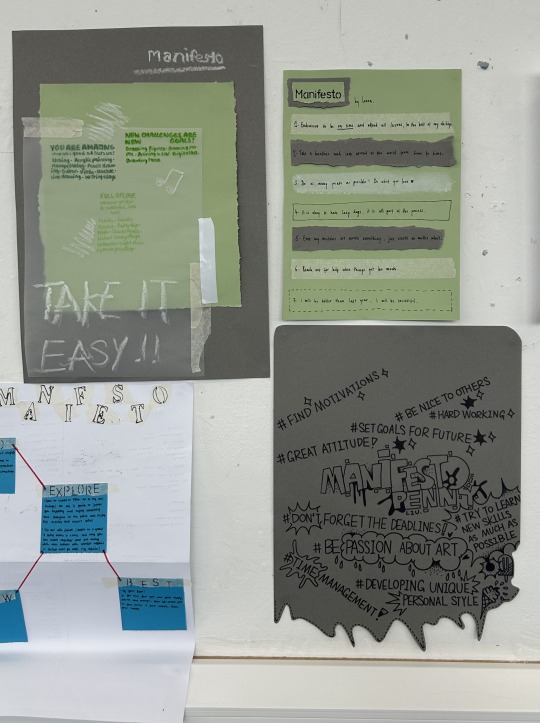

2 notes
·
View notes